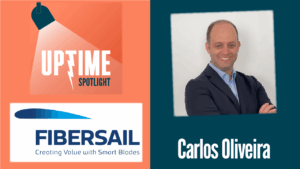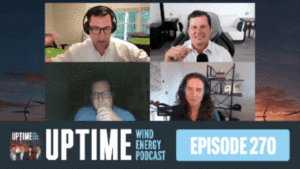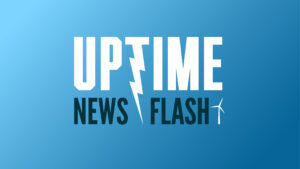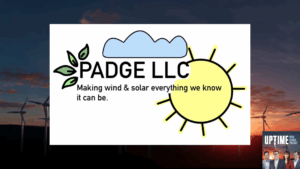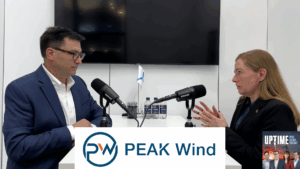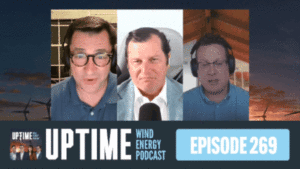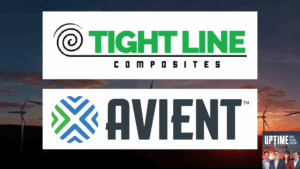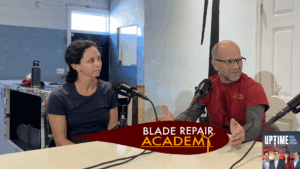Podcast: Play in new window | Download
Will Howell discusses Armor Edge’s thermoformed polycarbonate leading edge protection for wind turbine blades. Their solution helps to mitigate erosion, enhance aerodynamic performance, and extend blade life.
Allen Hall: Will welcome to the podcast. Thank you very much. Thanks for having me. So Joel and I have heard about Armor Edge for a couple, couple of years. Yeah. You’re based in Scotland. Yeah. And we haven’t seen you much in the United States and I haven’t physically touched it.
And of course we’re sort of tangible. We gotta play with the the product. So this is the first time now we’re here. Gotten to see the product. Yeah. Yeah. You wanna describe really what this product is for a leading edge protection?
Will Howell: Yeah, absolutely. So we are different to other LEPs out there on the market.
And really that was the whole point of our design evolution, was to try to overcome some of the traditional downfalls of some of the other LEDs that have been prevalent on blades. So. Um, yeah, we’ve been around since, um, well about eight, eight years now. And we’ve been out in the market installed since 2020.
So we’re, as you mentioned, Edinburgh, Edinburgh, Scotland is a kind of a base. So our first installs were all offshore, north North Sea, so offshore, Denmark, offshore [00:01:00] Germany. Very harsh, harsh environments. But we wanted to, to design an an LEP that was, um, really. Overcoming some of the traditional pitfalls.
So for us, that is the ease of installation, the longevity of the material, and also the a EP benefits that we, that we see. Um, as you see for the sample we have in front of us here today, it’s uh, only a small piece that we take to show just to, to, to show our clients and customers. Um, but typically the shields are 850 mil mil long.
Uh, they’re made of a, a custom thermoformed, um, polycarbonate, a SA blend. We get the material formed into sheets, and then we drape that sheet over custom design molds that are tailored for the specific blade types. And that’s how we get this perfect fit on every different blade that we’re, that we’re, um, that we have out, out there.
So let’s talk about the installation. Yeah.
Joel Saxum: Because that’s [00:02:00] a, that’s a really important one for me because on the podcast we always wanna talk about what problems we’re, what problems we’re solving. Sure. What problems you guys are helping the industry with. And one of the biggest ones with LAP, and it doesn’t matter what the product really is, if it’s tapes, if it’s coatings, if if it’s installed wrong, it’s not gonna last.
Yep. Yep. That’s, that’s the thing. So what have you guys done with this to help the technicians in the field to make it easier to make it. Last I want you to put on the line.
Will Howell: Yeah. I mean, I guess there’s a lot of technology in terms of the performance of the, of the product. Um, both the adhesive and the material itself.
But predominantly this was designed for rope access in the North Sea, so it had to be a product that the guys were. Able to handle up on, up on rope. Um, it wasn’t gonna be affected by climatic conditions as much, um, and would really lead to a faster, but also therefore, a higher quality installation because of the way that it’s put on, it’s not so much of a artisanal process that some of these other LEPs seem to [00:03:00] suffer from.
We want to. Train our technicians to deliver a high quality installation, but really you don’t have to be a master LEP installer to get our, to get our kit on, our kit on Blade. And that’s the feedback we’ve been getting from the technicians is that they find it, uh, easy to handle, easy to apply process, uh, in the field.
Joel Saxum: What does Blade Prep look like before you put it on?
Will Howell: Well, another unique. Facet of the system is because the shields themselves are custom formed from a a semi-rigid material. The leading edge of the shields themselves doesn’t conform to the existing erosion on the blade. So in terms of applying this to the blade surface, if you have existing cat one, two, or three erosion.
You don’t need to repair that and bring it back up to the original design intent. Air Aerofoil. In fact, you just need to remove the loose or flaking material. Do a final clean with an with an IPA. Then you’re ready to apply the adhesive into the target area. I. Draw the adhesive down with our custom tooth [00:04:00]spreader and then apply the shield straight on top.
So you’re actually using the, the high performance MMA as a high build filler behind the shield itself,
Joel Saxum: basically like, uh, like if you’re setting tile.
Will Howell: Yeah, very similar. Very similar. You scrape the mud down and it
Joel Saxum: creates a couple paths
Will Howell: and, exactly, exactly. The adhesive itself is very high performance, so the
MMA that we use has got a very high gap fill. Indeed. It can gap fill up to an inch if you had some severe holes on there without overheating. Um, but it can also be installed within. Any humidity, any dew point is indifferent to those conditions, as well as from freezing point right up to very high temperatures, kind of 110 degrees Fahrenheit.
Um, and we’ve, we’ve seen those conditions we’re installed across four different continents now, majority starting over in Europe, offshore, and now we’re. Some North India. We’ve got some in Southern Australia, and now the states, the past couple of couple of seasons where Iowa, Wisconsin, [00:05:00]Michigan, up in the north are kind of colder climbs as well as the southern states, Texas, Oklahoma, New Mexico.
The polycarbonate is slippery. It is. Yeah. Yeah. So does it accumulate ice? We haven’t had any specific testing on that, but we haven’t had any negative reports either. We’ve been less, we’ve been, we’ve been, we’ve been out there in the field now for five years. We’ve never lost a shields due to de bonding, we’ve never had any damage to any shields reported to us.
It’s a very resilient product, so we don’t believe that I. Has a particular attraction to the material, no worse than a traditional top coat. Um, we’ve actually been speaking to the guys from phase break who, who you’ll know with their nine ice products and they’re happy that you can apply nine ice over the top of this if you wanted to kind of double up that protection.
Allen Hall: Yeah, because that, that does make a lot of sense. If, if we’re talking North Sea and Iowa, those are two wildly in different environments. But the research I’ve done on your [00:06:00] material. I, I, I probably saw your early 2020 is when I first, I remember seeing Armor Edge and thinking, okay, these guys are onto something.
Knowing a little bit about leading edge rosn on aircraft and how we deal with it there. Mm-hmm. The technical details made sense to me. I hadn’t seen it in a shell form. Oh, there we go. Yeah. Yeah. Okay. So this, this makes a lot more sense now. So then when you actually get on a blade offshore, which would be the probably the ideal case because the return on investment is like instantaneous on these bigger turbines that you’re just, you’re just doing very little prep at all.
Then you’re just basically knocking off the little particles that are maybe hanging on applying MNA and then just. Starting where from the root working down, if we go from the tip up, we actually work
Will Howell: from the, uh, tip. Yeah. So one of the facets of our system, compared to the traditional soft shells or the tapes, you don’t have to manipulate and stretch the material over the nose of the, of the, uh, [00:07:00] blades.
The first shield is actually a, a section with a pressure suction side and a closed end. So it simply fits over the top of the tip. Like a suck gives you a very Exactly. It gives you a very. Solid boot to kind of start from, and then you work in series from, from there in sections around 850 mil long, working in the direction of the of, of the route.
Our customers have different lengths of application that they like to work to. We work in sections, but typically around 20% of the blade is, is kind of what we cover. Okay. Yeah. I, I
Allen Hall: wonder how far they were gonna go inboard, because I’ve seen some where they go really far inboard, like six to
Joel Saxum: eight meters.
Yeah.
Allen Hall: Yeah. So you’re, you’re not going all that far. Yeah. Typically.
Will Howell: You know, on the onshore machines here, some of the typical GE blades, the 56.962 point twos up at the 10, 12 meters or so. Okay. It’s, it’s just kind of a typical Okay. That
Allen Hall: makes, that makes sense. Then, so the, the process goes clean the blade apply MMA, put these [00:08:00] sections on, do the interlock, and what do you do with the trailing edge?
Will Howell: Yeah, absolutely. So again, it’s a. An issue that we’ve seen on other, on, on other systems of either one really long piece, which is almost impossible to handle with a pair, a pair of texts, or having many separate pieces with a complicated join that leaves it very exposed. Our sections are formed and then they’re very accurately CNC cuts, and we have male and female features on either end that interlock with, um, on, on two sides of the, uh, of the leading edge cord.
And so the technicians can’t get them the wrong way round. They made up completely butting against each other, leading to a very flush flash. Fit over that leading edge. Leading edge section.
Joel Saxum: Yeah. ’cause I could, I could picture like if something like this wasn’t here and they were just flat, like they’re kind of like it walking off Yeah.
Kind of getting wonky on the late edge. But this is gonna keep ’em locked in.
Will Howell: Exactly. This is alley. And so that just, you just working, working sections towards the, towards the roots, the adhesive that we use. Even though it’s an MMA, which [00:09:00] traditionally there have been some quite brittle MMAs on, on the market, we’ve, we’ve worked to find a very flexible and com and compliant that actually works as the sealants as well.
So you apply the shield, you apply pressure to the shields from the, from the leading edge, working down the pressure and suction side. You’re expelling adhesive down the trailing edges, and it’s that you are then fairing off to seal and also give you a weatherproof seal. And a aerodynamic chamfer as well, or just on that trailing edge.
The material on the leading edge typically starts around two mil, and it naturally tapers to about one mil on that, on that trailing edge. But we’re trying to minimize that as much as possible during the installation process. Sure. So 80 thousandths of an inch to under 40 thousandths. That’s pretty good.
Joel Saxum: Yeah. Yep. Ly ly. You mentioned at the beginning of kind of the, of us chatting here that also it’s creating a great aerodynamic edge. So have you guys actually validated like a EP increases from eroded blades?
Will Howell: Absolutely. [00:10:00] So, um, I mean, typically in terms of. The standard repair categories, we would consider anything that’s category one could be anything from zero to 1%.
Loss of a ap. Category two could be one to 2%, and category three could be up to three to 4% of AP loss. So you could really be losing significant amounts of power if you let your blades get up, get up to there. So we’re trying to educate our customer base to say leading edge protection is not just to protect the structural integrity of your blades.
You are, you are actually losing generation here, so. Applying an LEPI think the industry has maybe been a little bit kind of, uh, overzealous in their, in their claims. I would say if you are sticking anything to an air of foil, there may be some form of negative impact, and we have to accept that. We’ve conducted our studies though, both CFD and wind tunnel testing, and we can provide a report to any of our, any of our customers, showing an expected loss of half percent, so about negative 0.8% or so of a, of AP loss [00:11:00] when you apply it to a Virgin Blade.
However, when we see in field installations, you’re applying to an already eroded blade. So in fact, we typically see an AP uplift, and that’s what our customers see. Um, and it’s not only that initial day one increase that they’re seeing, but because we’re working with a polycarbonate instead of the traditional coatings or TPU tapes, the TPU tapes, tear and fisure, and they get that really rough surface, which has got a huge impact on a p.
Can even lead to noise complaints and flapping and all those sort of bad things that we don’t want on our blades. And so when a polycarbonate erodes, it’s more just like a, a smooth surface. Um, it doesn’t have those fis, those gaps that pitting. And so even during the life cycle of the erosion on a piece of arm edge material, you’re not seeing that same.
A EP hit.
Joel Saxum: So, I mean, a really important thing in LEP, like we’re in the states now, we’ve got 10, basically 10, 11 year life of a turbine. Yep. So we want all of our products to last that long. Right. Absolutely. With [00:12:00] PTC credit stuff, but offshore not the same story over, like in the North Sea, they want those turbines to last as long as possible.
Absolutely. Yeah. Yep. What I mean this, when I look at this, I go, I don’t. See this? I don’t see this wearing out. Well, what are you, uh, what’s the, what’s the expected lifetime of something like that?
Will Howell: So we’ve conducted brain erosion testing both within the UK and, uh, with our partners over in Denmark and.
The rain erosion testing produces a VN curve. You then apply a, uh, traditional North sea conditions, weather conditions to that VN curve, and we’ve seen the calculations there. Give us just over a 50 year lifespan, 5, 0, 50, 53 years. Yeah. Yeah. Um. You know, that’s on just a very basic rain erosion test test data.
So your mileage may vary as they say. Yeah, yeah, of course. But look, that gives us the confidence to go out into the market and say, we are selling a products that we expect to last a lifetime of the, of the blades. Yeah. So what, it’s one fit product.
Allen Hall: What turbines do you have molds for right now to, to make these pieces?
Uh, we’ve got,
Will Howell: I [00:13:00] think over, over 40 designs in our, uh, library. Library now. So we’ve, we’ve gone out and scanned as many blades as we can. We. Conduct a, a laser scan, um, to capture the geometry. We then work with a, a tool maker to, to create the tooling and then we mold the parts from there. So yeah, over 40 different models.
Predominantly the Siemens vest as now roving the state is a lot of, of the big GG blades. So anything from the kind of. Yeah, one x and two x PLA platforms we, uh, cover. So we’ve done I think over a thousand blades now. We’re, um, getting really good, really good feedback. So yeah, we can produce parts within a few weeks for the majority of the popular machines out there.
Allen Hall: Wow. Alright. That’s great. For operators, that is particularly offshore. And back to Joel’s point, if you need a turbine to be operating 20, 30 years, you need those blades to be there working. It is time to invest. You don’t do it at year 15 trying to get to 20. You wanna do it at year four, early.
Will Howell: [00:14:00] Exactly.
Early. And look, I mean, we’re, we’re actually already in conversations with the, a few of the bigger O OEMs about, um, about factory fit trials, because that’s the, that’s the, the perfect opportunity to get your blades fully protected before they even, they even fly. We have our first. Factory fit trial, um, should be next, next month, starting, starting now with one of the, one of the bigger OEMs.
Um, and we’ve got a couple others who are really interested in that, so it may actually be even a, a revised process when it comes to factory fit and we can discuss how to optimize that further to improve their, their workflow. But they can then still benefit from the performance of the Armor edge system.
If I am
Joel Saxum: a wind turbine operator owner, I’m doing that. I’m putting LEP on in the factory. I mean, if, if someone goes, if, if I go to the. My, my local friendly turbine salesperson and I say I want LEP in the fa. I want all the options given to me. I want an upgraded LPS system. I want [00:15:00] LEP put on in the factory.
I want all the bells and whistles ’cause I don’t want to deal with it. Right. I think that’s why you start to see, okay, like a product like this and you mentioning like Iowa, not usually, you wouldn’t think of Iowa being a crazy leading edge erosion place, but it is. We see it all the time, but for me, this is like, I’m going right to something like this.
’cause I want it to be done. I don’t want to deal with it anymore. I don’t want no more phone calls. I don’t wanna deal with any LEP issues.
Will Howell: Yeah. Yeah. I mean, even on, even on day one of the install, we feel that. We’re already offering a better value proposition, even compared to the traditionally very cheap coatings, for instance, where you can pi pay a relatively low price per meter for the materials, but even then you might have to do a few coats and it takes quite a long time.
It takes a long time to to cure.
Allen Hall: As an operator. It makes total sense. Yeah, yeah. To do that. Yeah. Do it.
Will Howell: You know, you’re, you’re talking protection of the blade from structural damage at that point.
Your improvements of the a EP, um, we’re the. OMO and m and s conference here today. [00:16:00] You’ve got less guys having to go up on blades, risking themselves to actually do these repairs, and the just the repeated cycles of intervention that we see in the industry for LEP and blade repairs on the, on the, on the leading edges.
Hopefully we can help to mitigate some of that.
Even if you have maybe some. Um, OEM specified, LEP from the factory. That maybe doesn’t last very long, but you are tied into a five year warranty period, or a service contract then. Yeah. We’ve been dealing with, with lots of, um, owners who are coming to the end of that period and thinking right now’s the time to get a, a high performance LLEP on.
They can specify arm reg from a, a basket access, which I think is the fastest we’ve measured so far. You can get a machine completed by a two man basket. 10 meters per blade in about a day, a day and a half per machine. So it’s really quite a rapid install. And of course that’s taking into account the benefits of.
Not having to repair that blade leading edge, not having to [00:17:00]manipulate difficult materials when you’re up on rope board basket.
Allen Hall: So where would an operator or an OEM go to learn more about
Will Howell: Armor
Allen Hall: Edge?
Will Howell: Well, um, our website has plenty of information, so that’s just armor edge.com. Um, where. Yeah, based over in Edinburgh, Scotland, if you’re ever over there and want to come, want to come say hey.
Um, we also do a lot of work now in the states with a number of different, um, I ISPs over here and we are happy just to try and get the name out out there more. I mean, you guys alluded to it, we’re not as well known, uh, kind of brands over here, but. We are very well established in terms of the supply base already and it’s about informing the owner, owner operators and informing the installers who are working with materials.
Um, and yeah, we’re getting really positive feedback to anyone that we’ve been dealing with. We gotta remember that they’re in Scotland. So Armor Edge
Joel Saxum: is AR MOUR. That’s
Will Howell: right. I have had it mentioned a few times this week. Yeah. Yeah.
Yeah, so check out Armor Edge online, learn about [00:18:00] more, learn more about their products, and if you need more information, you can get a hold of Will via LinkedIn.
Yeah. Thank you. Appreciate it. Thanks, will. Great. Cool. Easy. Nice. Done. That was good.
Allen Hall: Nice. Okay. That’s good. That was great. Good ton of information given away there. I hope that wasn’t.




